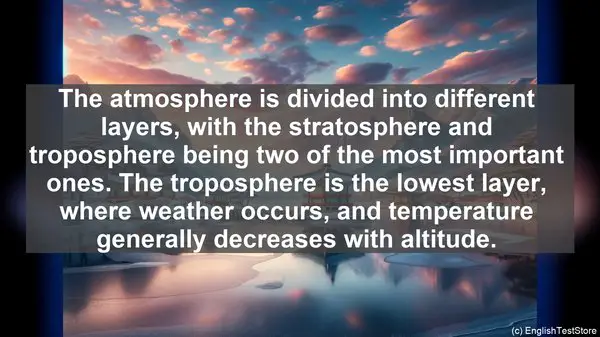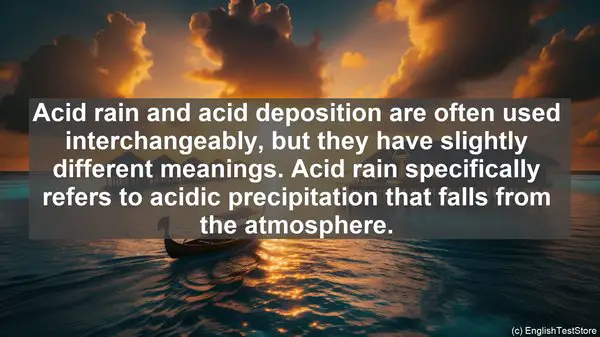Introduction
Welcome to today’s lesson on atmospheric chemistry. In this lesson, we’ll be focusing on the top 10 commonly confused words in this field. Understanding these terms is crucial for a solid foundation in atmospheric chemistry. So, let’s dive in!
1. Aerosol vs. Gas
One of the most fundamental distinctions in atmospheric chemistry is between aerosols and gases. While both are present in the atmosphere, aerosols are tiny solid or liquid particles, while gases are composed of individual molecules. This difference has significant implications for their behavior and effects on the environment.
2. Weather vs. Climate
Weather and climate are often used interchangeably, but they refer to different aspects of the atmosphere. Weather describes short-term conditions, like temperature and precipitation, in a specific location and time. Climate, on the other hand, is the long-term average of these weather patterns. Understanding this distinction is crucial when discussing climate change.
3. Ozone Layer vs. Greenhouse Effect
The ozone layer and the greenhouse effect are both important phenomena in atmospheric chemistry, but they serve different purposes. The ozone layer, located in the stratosphere, protects us from harmful UV radiation. The greenhouse effect, on the other hand, is the trapping of heat in the atmosphere, which is essential for maintaining Earth’s temperature. While the ozone layer depletion is a concern, the greenhouse effect is a natural process that, when intensified, leads to global warming.
4. Primary vs. Secondary Pollutants
When discussing air pollution, it’s essential to differentiate between primary and secondary pollutants. Primary pollutants are directly emitted into the atmosphere, like smoke from a factory. Secondary pollutants, on the other hand, are formed through chemical reactions in the atmosphere, such as the conversion of nitrogen oxides into ozone. Understanding this distinction helps in designing effective pollution control strategies.
5. Acid Rain vs. Acid Deposition
Acid rain and acid deposition are often used interchangeably, but they have slightly different meanings. Acid rain specifically refers to acidic precipitation that falls from the atmosphere. Acid deposition, on the other hand, includes not only rain but also other forms of acidic deposition, like snow and fog. Both can have detrimental effects on ecosystems and infrastructure.

6. Photochemical Smog vs. Industrial Smog
Smog is a visible air pollution that often plagues urban areas. It’s important to distinguish between photochemical smog and industrial smog. Photochemical smog is formed through the reaction of sunlight with pollutants like nitrogen oxides and volatile organic compounds. Industrial smog, on the other hand, is primarily a result of the burning of fossil fuels. Understanding the different sources of smog helps in devising targeted mitigation strategies.
7. Residence Time vs. Lifetime
When discussing the fate of pollutants in the atmosphere, residence time and lifetime are often mentioned. Residence time refers to the average time a molecule spends in a particular reservoir, like the atmosphere. Lifetime, on the other hand, is the average time it takes for a molecule to be removed from the atmosphere. While related, these terms have distinct meanings and are used in different contexts.
8. Stratosphere vs. Troposphere
The atmosphere is divided into different layers, with the stratosphere and troposphere being two of the most important ones. The troposphere is the lowest layer, where weather occurs, and temperature generally decreases with altitude. The stratosphere, located above the troposphere, is where the ozone layer is found, and temperature increases with altitude. Understanding these layers helps in comprehending various atmospheric processes.

9. Particulate Matter vs. Volatile Organic Compounds
Particulate matter and volatile organic compounds (VOCs) are two types of air pollutants. Particulate matter refers to tiny solid or liquid particles suspended in the air, like dust or soot. VOCs, on the other hand, are organic compounds that easily vaporize at room temperature. Both can have adverse health effects and contribute to air pollution, but their sources and behavior differ.
10. Nitrous Oxide vs. Nitric Oxide
Nitrous oxide and nitric oxide are both nitrogen oxides, but they have different properties and effects. Nitric oxide (NO) is a reactive gas that plays a role in atmospheric chemistry, including the formation of ozone. Nitrous oxide (N2O), on the other hand, is a potent greenhouse gas. Understanding their distinct characteristics is important when studying their impact on the environment.
